Excerpts from Jim Conrad's
Naturalist Newsletter
From the March 31, 2008 Newsletter written in the community of 28 de Junio and issued from a ciber in Pujiltic, Chiapas, MÉXICO
{at about 800 meters in elevation, ± LAT 16° 18'N, LONG -92° 28'W.}
EATING PIÑUELA FRUITS IN CHIAPAS
In the transition zone between weedy, hacked-over scrub down below and open oak forest higher up a conspicuous member of the Bromelia Family appeared. You may remember the abundandant bromeliads gracing tree limbs at Yerba Buena in the Chiapas uplands. The species encountered on Cerro de Cruz Grande differed from those species both by being terrestrial and by growing much larger, as you can see below:
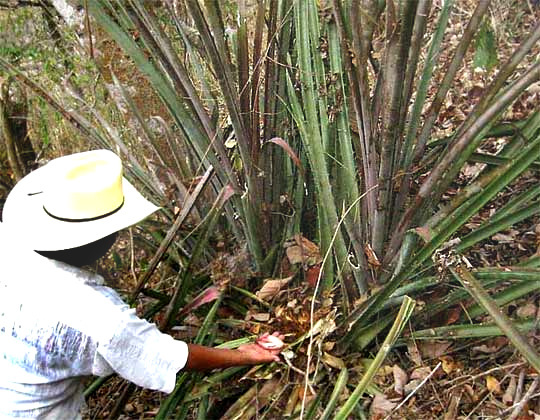
This is Piñuela (pee-nyoo-EH-la), BROMELIA KARATAS. In the picture Andrés is holding in his hand the thing that makes the plant famous in these parts: Some tasty fruits. You can see a close-up of the fruits below:
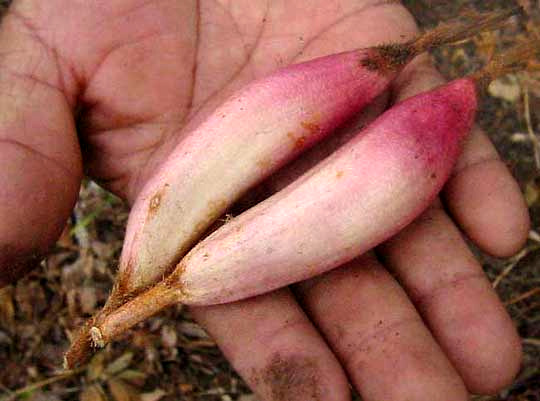
Piñuelas were common in the scrub back in the Yucatan and I always wanted to sample a fruit but never got to. I thought my failure to find a fruit was because I always left the Yucatan before the fruits ripened but now I suspect it was because I didn't know you had to dig down into the leafy debris gathered in the plant's center, as shown in the first photo. Andrés knew exactly where to thrust his hand into the clutter, though, and came up with fruits his first try.
Before anything is done with the fruits you need to thoroughly brush or wipe off the rusty-brown, very thin, sharp hairs visible in the fruit picture mantling both ends of the fruits. If a hair lodges in your lips or tongue it stings for a long time. The fruits are a little like small bananas, in the sense that you must peel off the tough covering to get at the sweet interior. Piñuelas can be cooked in campfire embers but they're also good raw. Andrés warns to not eat more than one, though, because if you do you'll develop burn-blisters, same as if you eat too much pineapple.
In fact, Piñuelas are closely related to Pineapple plants. Both are in the Bromelia Family and both are among the small minority of terrestrial bromeliads. The Piñuela fruit tastes a bit like pineapple, but contains hard seeds.
from the October 29, 2017 Newsletter issued from Rancho Regensis north of Valladolid, Yucatán, MÉXICO
PIÑUELAS FRUITING
Piñuela, BROMELIA KARATAS, along with the vegetatively similar Bromelia piguin, is fairly common in the scrubby forest around the rancho, but wherever and whenever the plants are found normally they're not producing fruits. However, this week one plant was encountered absolutely loaded with immature fruits, as you can see below:
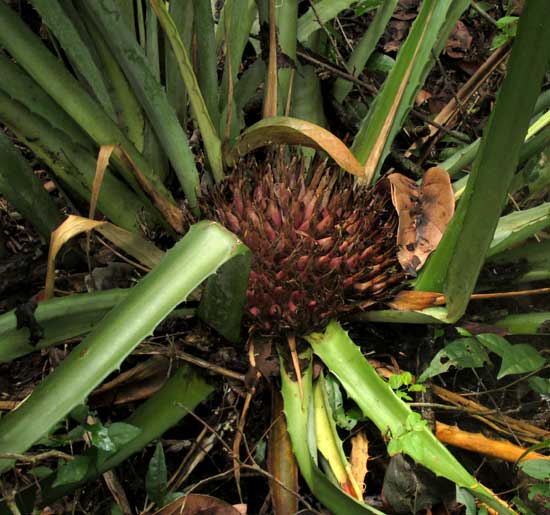
A close-up of some fruits is shown below:
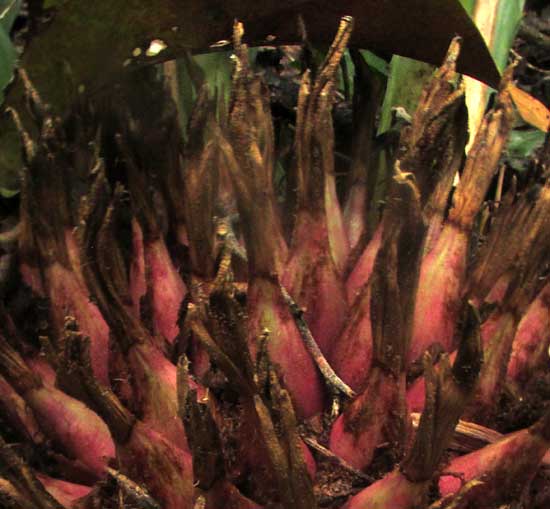
I'm keeping my eye on this plant, hoping to enjoy some ripe Piñuela fruits later on.
from the March 11, 2018 Newsletter issued from Rancho Regenesis in the woods ±4kms west of Ek Balam Ruins, central Yucatán, MÉXICO
PIÑUELA FRUITS RIPE
Now five months after the above photos were taken, fruits of the same plant featured last October are ripe enough to harvest, simply by taking hold of a fruit and pulling on it as you wiggle it back and forth. Below, you can see my hand withdrawing a fruit:
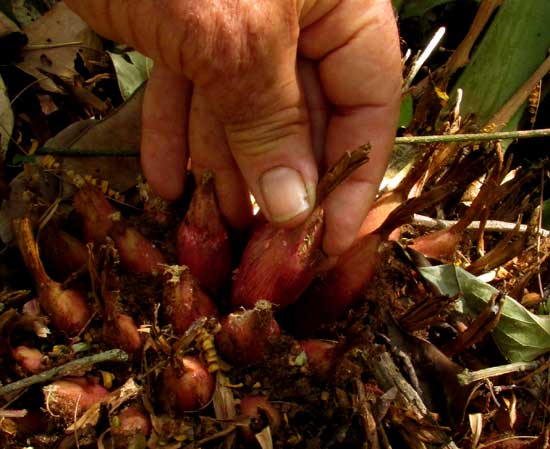
A full view of a ripe fruit is shown below:
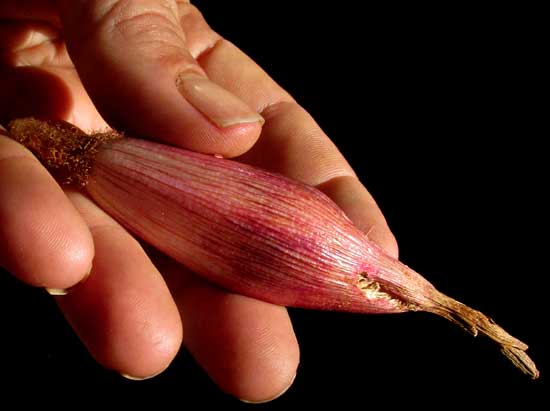
The fruits often bear stinging hairs, but these didn't. A fruit sliced longitudinally to show numerous hard, black seeds embedded in the succulent flesh appears below:
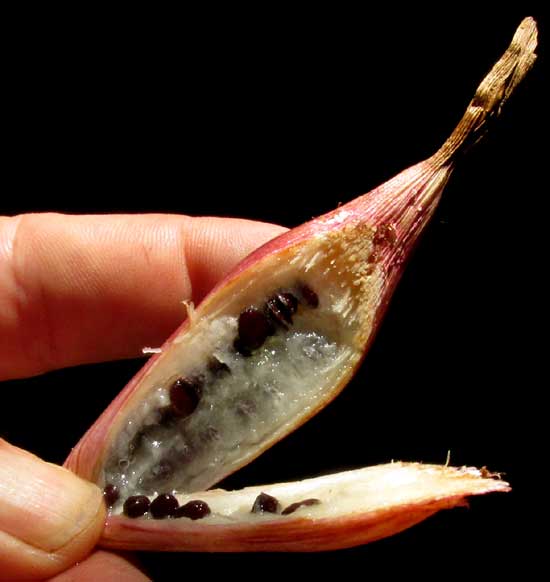
If pressure is applied behind a fruit sliced as shown above, the sweet flesh pops out presenting itself for eating, as shown below:
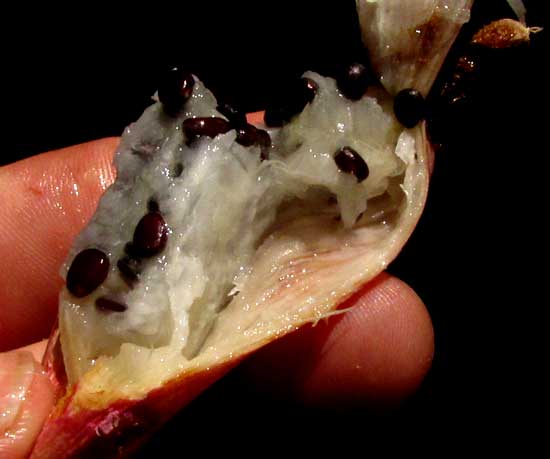
The flesh is sweet and tasty -- sweet-sour, one author writes -- but if you're not thinking "pineapple" you might not notice much similarity with the pineapple flavor. When we were in Chiapas my friends told how Piñuela fruits can be cooked over campfire embers, and that if more than one raw fruit is eaten you might develop burn-blisters. Many people experience mouth-burn even if they eat too much regular pineapple.
Numerous traditional medicinal uses have been documented for this Piñuela's fruit juice. It's used to treat scurvy and diabetes, and an alcoholic tincture of it is used for ulcers. Boiled and mashed seeds sweetened with sugar are said to expel internal parasites.
from the May 31, 2018 Newsletter issued from Rancho Regenesis in the woods ±4kms west of Ek Balam Ruins, central Yucatán, MÉXICO
PIÑUELAS FLOWERING
Nowadays Bromelia karatas is flowering, and you can see the colorful event below:
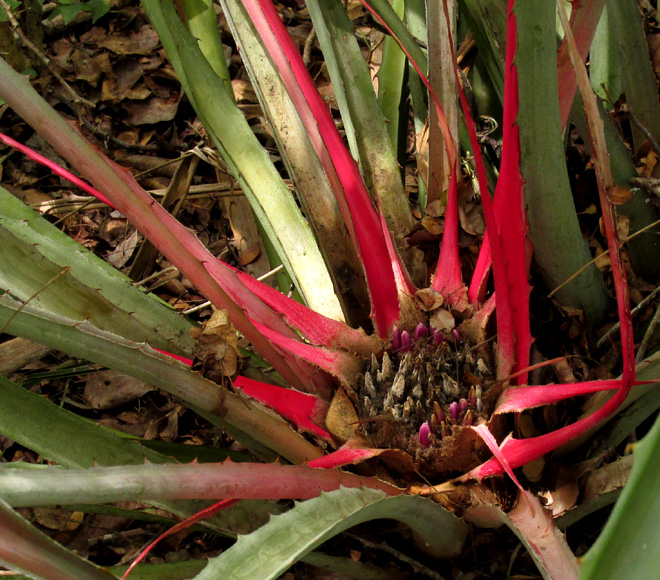
In that picture notice that around the edge of the cluster of brown-gray things in the plant's center, purplish flowers are arising. A close-up of some flowers rising amid masses of cottony fiber is shown below:

On our Bromelia karatas page we see how Don Vicente in Sabacché taught us to use that fiber for staunching blood.
The two species' flowers are very similar, but they're displayed very differently. Flowers of Bromelia pinguin are arranged in large panicles atop a stout stalk, while above you see that blossoms of Bromelia karatas, as with its fruits, cluster down in the plant body's center.
In March when Bromelia pinguin was flowering, the plant's newer leaves often were red, while at that time when Bromelia karatas was fruiting, that species' leaves were all green. Now we see that when Bromelia karatas flowers, its newer leaves also can be red, and when I inspect the same Bromelia karatas plants that last March bore red leaves, now those plants' leaves are all green.
From the August 25, 2008 Newsletter written in Sabacché and issued from a ciber in nearby Tekit, Yucatán, MÉXICO
PIÑUELA FUZZ FOR STAUNCHING BLOOD
The other day I met Don Vicente out in the scrub and he showed me how to reach into a big, stiff-bladed, spine-margined Piñuela the way Andrés had done earlier, but this time Andrés retrieve the pinch of pale orange fuzz you can see below:
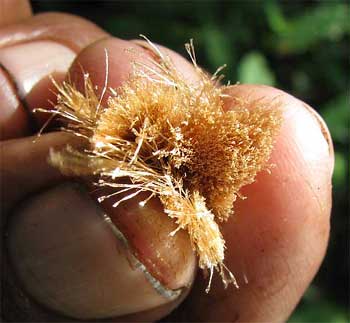
"If you're gathering firewood and you cut yourself so that the blood just runs down your arm," he said, "you go collect this fuzz. Spread it over your cut as if it were a bandage, and it'll stop the bleeding."
I've run into lots of blood-staunching remedies like this and I always wonder whether the thing being talked about possesses a particular chemical that staunches the blood, or whether just about any powder or fine-textured material will do. I carry Golden Seal powder for cuts, and we all know that placing a small patch of toilet paper over a cut will staunch it. In some cultures spider webs are placed over the cuts.
I think the main idea is to provide lots of surface area over which the blood's platelets can arrange themselves, and most powders, most thin-pulpy tissues, most wads of slender filaments, and most fuzzes will do the job.
Or maybe really there's a special chemical coating Piñuela-fruit fuzz that almost magically orders the blood's platelets just the way they need to be to work effectively, and that chemical is just waiting to be discovered by science.
In the scrub around Sabacché Piñuelas are abundant, but in August, the middle of the rainy season, there are no fruits, just the soft fuzz.